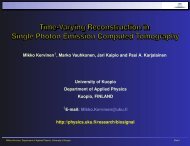USER'S GUIDE - Biosignal Analysis and Medical Imaging Group
USER'S GUIDE - Biosignal Analysis and Medical Imaging Group
USER'S GUIDE - Biosignal Analysis and Medical Imaging Group
- No tags were found...
Create successful ePaper yourself
Turn your PDF publications into a flip-book with our unique Google optimized e-Paper software.
1.5. Structure of this guide 15After the overview chapter, from where you will find useful information about the systemrequirements <strong>and</strong> installation, an introduction to heart rate variability is given in Chapter 2.This chapter starts with a short discussion on the control systems of heart rate after whichthe extraction of heart beat periods is discussed <strong>and</strong> the derivation of HRV time series isdescribed. The rest of the chapter is focused on the preprocessing of HRV data <strong>and</strong> gives adetailed description of the smoothness priors based detrending approach.In Chapter 3, the analysis methods included in the software are described. The descriptionsof the methods are divided into time-domain, frequency-domain, nonlinear, <strong>and</strong>time-varying categories <strong>and</strong> a summary of the methods is given at the end of the chapter.For most of the methods, exact formulas for the different variables are given <strong>and</strong> possibleparameter selections are pointed out.In Chapter 4, the description of the features <strong>and</strong> usage of the software is given. First,the input data formats supported by the software are described <strong>and</strong> then the user interfacethrough which the software is operated is described. Then, different options for saving theanalysis results are described <strong>and</strong>, finally, instructions on how to set up the preference valuesfor the analysis options are given.In Chapter 5, two sample runs of the software are presented. The first sample rundescribes how to analyze the lying <strong>and</strong> st<strong>and</strong>ing periods of the orthostatic test measurement(distributed along this software) separately as stationary segments. The second sample run,on the other h<strong>and</strong>, describes the time-varying analysis procedure of the same measurement.In Appendix A, some frequently asked questions with answers are given. The questionsare selected based on the feedback obtained from the users of the previous version of thissoftware.Finally, in Appendix B, workarounds for some commonly encountered technical problemsare given.Kubios HRV <strong>Analysis</strong>version 2.0 beta<strong>Biosignal</strong> <strong>Analysis</strong> <strong>and</strong> <strong>Medical</strong> <strong>Imaging</strong> <strong>Group</strong>Department of PhysicsUniversity of Kuopio, FINLAND





